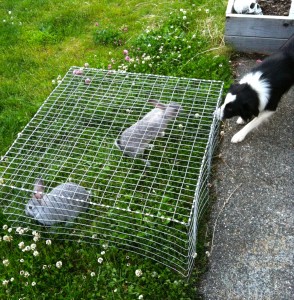W e’ve started pasturing our rabbits. We spent the first few weeks we had the rabbits slowly/progressively getting them used to fresh grass and clover. They adapted well as evidenced by their continued solid poops and healthy growth. We’ve now started taking them out of the rabbitry daily and putting them under a movable “rabbit tractor’ in the backyard. We have a good growth of clover and the white clover we planted in the spring is finally starting to come up, so the rabbits should have plenty to eat; hopefully they’ll eat enough to make up over half of their diet. We’re still feeding them rabbit pellets and dried grass hay, but they have been eating progressively less.
e’ve started pasturing our rabbits. We spent the first few weeks we had the rabbits slowly/progressively getting them used to fresh grass and clover. They adapted well as evidenced by their continued solid poops and healthy growth. We’ve now started taking them out of the rabbitry daily and putting them under a movable “rabbit tractor’ in the backyard. We have a good growth of clover and the white clover we planted in the spring is finally starting to come up, so the rabbits should have plenty to eat; hopefully they’ll eat enough to make up over half of their diet. We’re still feeding them rabbit pellets and dried grass hay, but they have been eating progressively less.
Even though the rabbits are still several months away from breeding and producing litters we are already benefiting from their manure. Rabbit manure is the most concentrated fresh animal manure available (NPK), it can be put straight onto the plants, it breaks down relatively quickly, and has no smell. The chart below shows how it compares with other livestock manure (the others all need to be composted before adding to the garden, and many have a strong odor).
| Material | Nitrogen (N) % | Phosphorus (P) % | Potassium (K) % |
| Chicken Manure | 1.6 | 1.5 | 0.9 |
| Cow Manure | 0.3 | 0.2 | 0.1 |
| Horse Manure | 0.7 | 0.3 | 0.6 |
| Pig Manure | 0.5 | 0.3 | 0.5 |
| Rabbit Manure | 2.4 | 1.4 | 0.6 |
| Sheep Manure | 0.7 | 0.3 | 0.9 |
Since we don’t have enough to manure yet to cover all the plants, we’re maximizing what we have by making rabbit compost tea. We mixed a couple of large scoops of manure into a 5-gallon bucket of rain water (from our rain barrels); it’s been sitting for a couple of days and this weekend I’ll go around and water each one of the plants with it. We’ll especially get some extra on the tomatoes because their leaves are yellowing a little and I understand that means they’re low on nitrogen.
Unlike most of the country, Western Washington had cooler than normal temperatures in June. Our average high temperature for the month was 65.1 degrees, and we’ve only had six days that have reached over 70 degrees. We’ve also had 27 days with partly cloudy or cloudy conditions. Because of our cooler temperatures and lack of sunshine our garden hasn’t done much yet. It hasn’t suffered but it certainly hasn’t “bloomed” either. Most of the plants are about the same size as when we put them in the ground, with the snap peas and potatoes being the exception. This week we put more plants into the ground from the greenhouse, but we still have half of our tomatoes in there and the ones in the greenhouse are doing better. While we know much of the country is suffering from hot temperatures we’re jealous of their garden productions and early harvests. We’re ready for summer to start here, July should be warmer and more sunny; it typically is, with a monthly average high of 75.3 degrees.
What did you do?















 Now that summer gardening is over, I wanted to get a jump on improving and expanding the growing space for next year. I hate watering grass, but the home owner’s association thinks it’s important, so I came to a ‘compromise’. I expanded the gardening area in the front yard so it now covers about a third of the yard. Next summer I’ll feel better about watering because now I’ll also be watering a garden. Removing the sod was a hassle, it’s a lot of work and it’s heavy.
Now that summer gardening is over, I wanted to get a jump on improving and expanding the growing space for next year. I hate watering grass, but the home owner’s association thinks it’s important, so I came to a ‘compromise’. I expanded the gardening area in the front yard so it now covers about a third of the yard. Next summer I’ll feel better about watering because now I’ll also be watering a garden. Removing the sod was a hassle, it’s a lot of work and it’s heavy.